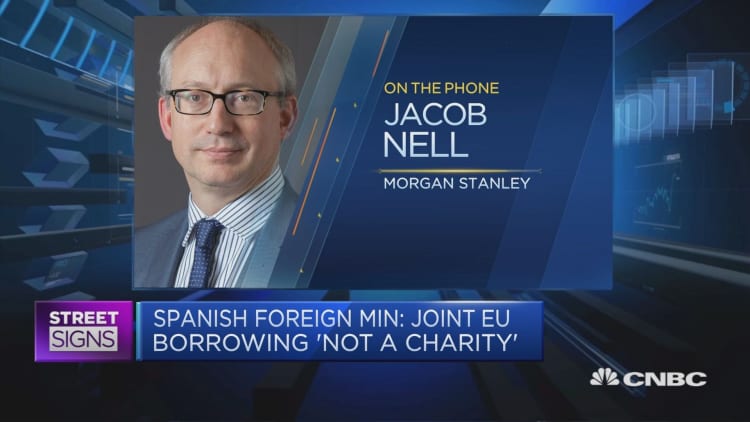How and where the EU spends its proposed coronavirus fund could have a big impact on Europe's recovery from the pandemic, according to economists at Morgan Stanley.
The investment bank issued a note last week stating that the fund's impact could be determined by how much money goes toward what it called "constrained sectors," such as contact-intensive sectors like hospitality where output or demand will be constrained until there is a coronavirus vaccine, and "unconstrained" sectors, which can respond quickly to demand stimulus.
"A fund focused on unconstrained sectors where it can elicit a supply response — notably green and digital investment where support is also justified on other grounds — could transform Europe's economic prospects. By contrast, the boost to growth is likely to be modest if it falls on constrained sectors, either as part of an overt strategy to sustain those sectors for an extended period or as a by-product of across-the-board spending or tax cuts," Morgan Stanley economists led by Jacob Nell, head of European Economics and chief U.K. economist, said.
The European Union announced plans for a 750 billion euro pandemic recovery fund back in May as a way to overcome the economic damage wrought by the coronavirus. Two months later and EU member states are still wrangling over the finer details over the recovery fund, which will see the EU borrow the money, in part, on the global financial markets before disbursing it to its 27 members via grants and loans.
Speaking to CNBC Monday, Nell said the key decision facing Europe right now was "how much you're willing to put in these unconstrained, forward-looking sectors as opposed to playing defensive and supporting the existing sectors. Obviously, it's a very difficult political decision," he said.
"If you spend it (the fund) on supporting your constrained sectors like, say, hospitality and tourism, then they won't be able to respond because of the constraints of the virus and you'll have a low impact on growth, whereas if you invest in things like the green and digital transition, which aren't constrained sectors, then particularly in this situation where we've got a lot of spare capacity in the economy, you can have a very significant multiplier effect," he told CNBC's "Squawk Box Europe."
The bank modeled three scenarios with varying proportions of support for what it sees as "constrained" and "unconstrained" sectors.

In its base-case scenario, which it called a "balanced mix" of support, it envisaged that the recovery fund could boost euro area, Italian and Spanish growth respectively by 0.6 percentage points (pp), 1.1pp and 1.6pp per annum for five years.
"While a fund focused on supporting constrained sectors ('defensive support') might have a modest impact, we think a fund focused on the unconstrained sectors ('offensive investment'), could add 1pp per annum to euro area growth, largely by more than doubling growth in the periphery," Morgan Stanley said.
"An ambitious fund could drive growth through investment in unconstrained green and digital sectors that are expandable at scale, such as renewables, home energy efficiency, fibre and rail. Targeting support at peripheral countries could amplify the growth impact, given their wider investment and output gaps," the analysis noted.
When the EU's proposed recovery fund, known formally as the Next Generation EU plan, was announced in May, the bloc said that a significant amount of funding would be available for investments that support green and digital sectors, which are strategic priorities for the region.
Nonetheless, the proposals face obstacles. There are divisions among European nations over the distribution and structure of the fund, for example, with a divergence between countries that favor loans instead of grants. A European summit in mid-June failed to reach an agreement over the proposal and another meeting is scheduled for mid-July to try to resolve the impasse.


